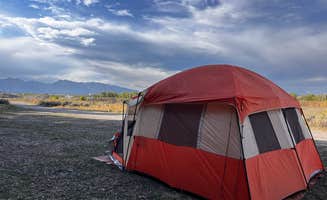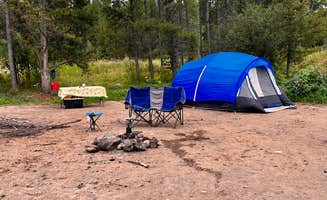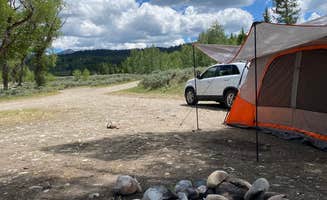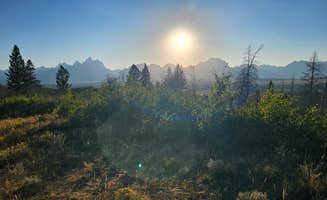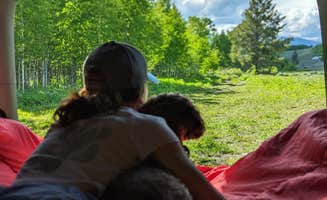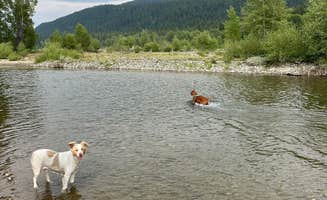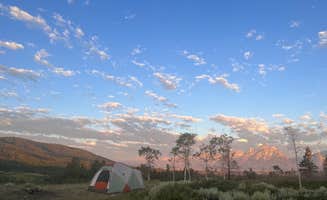Dispersed camping near Moran, Wyoming offers remote backcountry experiences within the Bridger-Teton National Forest at elevations between 6,800-8,000 feet. The eastern approach to these sites features sagebrush flats transitioning to lodgepole pine forests. Morning temperatures typically drop 20-30 degrees below daytime highs, even during summer months.
What to do
Fishing access points: Several dispersed camping areas provide direct river and creek access. At Buffalo Valley Designated Dispersed Camping, campers enjoy "Beautiful crystal clear river running right next to the site. It was frigid but perfect for a plunge before a day of hiking the Tetons," according to one visitor.
Wildlife viewing spots: The areas near Buffalo Valley Road offer excellent wildlife observation opportunities. One camper at Bridger-Teton National Forest reported, "I had elk around most nights and could hear the sandhill cranes calling down below." Morning and evening hours typically provide the best viewing opportunities.
Early season hiking: Trails accessible from dispersed sites become available weeks before higher elevation park trails. "We strolled the creek in the morning, and the dogs really enjoyed it," noted a visitor to Spread Creek. Most dispersed areas connect to forest service trails that see significantly less traffic than park trails.
What campers like
Private waterfront sites: Campers consistently praise the secluded spots along waterways. At Pacific Creek Designated Dispersed Campsite, "Can't speak to the rest of the sites but campsites 7 and 8 are excellent. Great access to and views of the river and it's nice and secluded," one visitor noted.
Multiple elevation options: The varying elevations provide different camping experiences. "We went in a truck camper on the flat top, but have ventured down the hill to other spots before," explained a Buffalo Valley camper, highlighting how the same area offers both panoramic overlooks and sheltered creek-side spots.
Bear boxes at designated sites: Many dispersed areas provide secure food storage. A camper at Shadow Mountain Dispersed Campsite #10 explained, "It had near 360 views, perfect for sunset over the Tetons," adding that proper bear protocols are essential as "the flies and mosquitoes were horrible!" This demonstrates the importance of proper preparation.
What you should know
Road conditions vary dramatically: Routes to many sites deteriorate quickly after rain. At Upper Teton View Dispersed, a visitor cautioned, "Great views but a little windy but worth it!" while another noted "The road up is a little rough but made it fine towing our 38ft 5th wheel."
Early arrival window narrows by season: Prime arrival times shift throughout the year. A visitor to Shadow Mountain observed, "We got here about 2:30pm on a Friday. May 30 2025. It had some people in the best spots but we were able to get a spot with a view."
Seasonal bug populations: Insect activity peaks from late June through August. One camper at Buffalo Valley warned, "Bring bug spray! There are soooooo many mosquitoes," while another added, "The mosquitos were terrible so we opted to sleep in the car for the night."
Cell service dead zones: Connectivity varies widely by carrier and exact location. At Spread Creek, a reviewer noted, "Cell signal very spotty. No trails to walk with dogs. Spots are spacious."
Tips for camping with families
Fire pit locations: Many sites include established fire rings with open areas for children to play safely. At Buffalo Valley Campsites 4-7, "There was a fire ring & a great view of the river, some homes off not too far away, so that made things feel more safe," noted one visitor.
Wildlife viewing routines: Regular wildlife appearances make for excellent educational opportunities. One camper at Bridger-Teton noted, "We woke up to cows breakfasting around our RV!" while others consistently report deer and elk sightings at dawn and dusk.
Proximity to facilities: Not all dispersed sites are equally remote. A Pacific Creek visitor explained, "There is a campground a bit farther down the road," noting that these nearby developed areas can provide backup facilities when needed.
Tips from RVers
Turn-around clearances: Several areas have limited maneuvering space for larger vehicles. A visitor to Buffalo Valley Campsites warned, "If you're pulling something or drive anything bigger than a midsize SUV, you might have a nightmare of a time turning around. I had barely enough room to do a multi-point turn in my 4runner."
Level site availability: Finding flat parking requires advanced planning. At Shadow Mountain, one RVer noted that "Many spots were already occupied. We started at 17:30...all lower spots were already taken, this was the last available one."
Access road difficulty ratings: Road quality varies dramatically by location. A visitor to Upper Teton View advised, "The first lot is decent, has great views but we preferred the second field a few miles past that one," adding that "Individual sites seemed great but mosquitoes were brutal when we were there."



